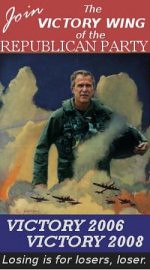But liberals will continue to try to fan any flames they can.
WASHINGTON (AP) -- Pentagon officials acknowledged Tuesday that U.S. troops used white phosphorous as a weapon against insurgent strongholds during the battle of Falluja last November.
At the same time, they denied an Italian television news report that the spontaneously flammable material had been used against civilians.
Lt. Col. Barry Venable, a Pentagon spokesman, said that while white phosphorous is used most frequently to mark targets or obscure positions, it was used at times in Falluja as an incendiary weapon against enemy combatants.
"It was not used against civilians," Venable said.
The spokesman referred reporters to an article in the March-April 2005 edition of the Army's Field Artillery magazine, an official publication, in which veterans of the Falluja fight spelled out their use of white phosphorous and other weapons. The authors used the shorthand "WP" in referring to white phosphorous.
"WP proved to be an effective and versatile munition," the authors wrote. "We used it for screening missions at two breeches and, later in the fight, as a potent psychological weapon against the insurgents in trench lines and spider holes when we could not get effects on them with HE (high explosive)" munitions.
"We fired `shake and bake' missions at the insurgents, using WP to flush them out and HE to take them out."
The authors added, in citing lessons for future urban battles, that fire-support teams should have used another type of smoke bomb for screening missions in Falluja "and saved our WP for lethal missions."
The battle for Falluja was the most intense and deadly fight of the war, after the fall of Baghdad in April 2003. The city, about 35 miles west of Baghdad on the Euphrates River, was a critical insurgent stronghold. The authors of the "after action" report said they encountered few civilians in their area of operations.
Italian communists held a sit-in Monday in front of the U.S. Embassy in Rome to protest the reported use by American troops of white phosphorous. Italy's state-run RAI24 news television aired a documentary last week that alleged the United States used white phosphorous shells in a "massive and indiscriminate way" against civilians during the Falluja offensive.
The State Department initially denied that U.S. troops had used white phosphorous against enemy forces. "They were fired into the air to illuminate enemy positions at night, not at enemy fighters," a department Web site said.
The department later said the statement had been incorrect.
"There is a great deal of misinformation feeding on itself about U.S. forces allegedly using `outlawed' weapons in Falluja," the department said. "The facts are that U.S. forces are not using any illegal weapons in Falluja or anywhere else in Iraq."
Venable said white phosphorous shells are a standard weapon used by field artillery units and are not banned by any international weapons convention to which the United States is a signatory.
White phosphorous is a colorless-to-yellow translucent wax-like substance with a pungent, garlic-like smell. The form used by the military ignites once it is exposed to oxygen, producing such heat that it bursts into a yellow flame and produces a dense white smoke. It can cause painful burn injuries to exposed human flesh. |
The Brits and Israelis have used the weapon very recently, but I've yet to find anything that would be particularly horrific about it's use. It's not toxic unless the terrorists are picking up the munitions and eating them, and it is used commonly as tracer rounds. I think of it as a weapon commonly referred to in the movies, a flash-bang. It's a weapon designed to startle, disorient, and flush out the enemy. It is not designed to kill, but can if suspects are too close to the grenade when it explodes. So even the BBC acknowledges that this is not a chemical weapon, the way that sarin and mustard gas are:
So WP itself is not a chemical weapon and therefore not illegal. However, used in a certain way, it might become one. Not that "a certain way" can easily be defined, if at all.
The US can say therefore that this is not a chemical weapon and further, it argues that it is not the toxic properties but the heat from WP which causes the damage. And, this argument goes, since incendiary weapons are not covered by the CWC, therefore the use of WP against combatants is not prohibited.
Critics claim that the US used chemical weapons in Falluja, on the grounds that it is the toxic properties which cause the harm. The UK's Guardian newspaper for example said: "The US used chemical weapons in Iraq - and then lied about it."
There is an intense debate on the blog sites about this issue. "It's not a chemical weapon" says Liberal Against Terror. "CONFIRMED: WP is a CW if used to cause harm through toxic properties," says Daily Kos. |
But don't expect this story to go away any time soon, because I can almost guarantee that liberals will continue to flog the dead horse with the standard "Bush lied, people died" mantra. Don't be fooled. |











